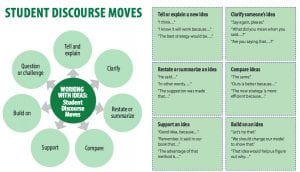We are immersed in Personalized Learning. The honeycomb, learner profiles, proficiency based progress, pathways, standards based grading, learning targets, and I can statements. For some educators this is invigorating, for others it is overwhelming. It is important to recognize that although we are all in a different place, we are taking steps to shift our practices so that they are student centered. That in itself is a celebration.
After working with a variety of Kaneland teachers embarking on this personalized learning journey and networking with educators in other districts, I have witnessed and learned about a plethora of different approaches to personalization. Without ranking or comparing where each journey starts and ends, one common strand stood out: student discourse, student choice, and student voice.
Student Discourse
I readily admit, this is one area where I can continue to improve. Simply, I enjoy the interaction with students immensely and I have to remember that their interactions with others can be just as impactful. As teachers, we often take the time to paraphrase what has been said in our class discussions. A simple move of asking another student to restate an answer from a peer in their own words shifts the learning back to the student. The following discourse moves are from a STEM resource, but can be used in any content area.

The following prompts are excellent for teachers to reflect on the discourse in their classrooms. The Association for Middle Level Education has shared some excellent tips on how to be sure teachers are including critical thinking opportunities for students.
- Is the emphasis on giving the right answers rather than processes and strategies?
- Do the verbal interactions follow the teacher-dominated initiation-response-evaluation pattern?
- Is discourse carried by the voices of a few where the others are reluctant to contribute?
- Do you often provide opportunities for students to lead the discourse?
- Do you model and insist wait-time be used as a key component of dialogue?
- Do you send non-verbal signals to students based on your perception of their ability to give a quick or correct response?
- Does your lack of comfort with content lead you to pose more close-ended questions?
Student Choice
Choice motivates students, there is no question. As we move from choice menus to allowing students to propose how they will show their learning, the possibilities are endless. By creating and implementing learning targets and having a clear understanding of what proficiency is, students have the opportunity not only to be more involved in constructing knowledge, but to attain life skills.
 Just this past weekend, I had a long list of what I needed to accomplish. Each day the tasks I completed were based on multiple factors related to what was happening around me, my energy level, and interest. Is it possible for students to have choice in this manner as well? Absolutely. Time management is such an important life skill that can be practiced at a young age. Author Nancy Sulla discusses this in detail in her book Students Taking Charge: Inside the Learner Active Technology Infused Classroom. She gives suggestions for elementary students through high school students and breaks down how to get started. Just this past month, she released a second edition of her book with a
Just this past weekend, I had a long list of what I needed to accomplish. Each day the tasks I completed were based on multiple factors related to what was happening around me, my energy level, and interest. Is it possible for students to have choice in this manner as well? Absolutely. Time management is such an important life skill that can be practiced at a young age. Author Nancy Sulla discusses this in detail in her book Students Taking Charge: Inside the Learner Active Technology Infused Classroom. She gives suggestions for elementary students through high school students and breaks down how to get started. Just this past month, she released a second edition of her book with a
Student Voice
After interacting with students while visiting classrooms this past month, one thing is clear. Students don’t hesitate to explain why having choice matters in their learning. Students appreciate the ability to work at their own pace, whether it is slower or faster than the norm. More emphatically, students appreciate the ability to support and mentor one another rather than sit quietly. They are eager to share their reflections on their learning and are developing their learner profile as they begin to advocate for themselves. I witnessed kindergarteners asking to work alone at a table so they can concentrate and a fourth grader advocate for change in a learning situation where she didn’t feel that her needs were being met. It is a celebration that our students are learning to advocate for themselves.
As we continue to give our students rich opportunities for discussion, choice throughout their day, and clear learning expectations, we are well on our way to personalized learning for our students. We can’t use a GPS, Maps or Waze to get there; there is not an optimal route. Some of us find that frustrating! What matters is that we are learning along the way, and adapting to what works best for our students. Enjoy the journey and don’t hesitate to reach out to an instructional coach to travel alongside you.